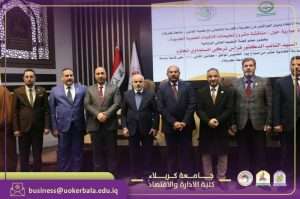Role of Government Investment Expenditure in Spatial Dynamism of in Inclusive Growth variables in Iraq
A Dissertation Submitted to the Council of College of Management and Economic, Karbala University, Requirements for the Degree of Doctor Philosophy in Economics
By
HABEEB SAADOUN UBEES
Supervised
Prof. Dr. Talib Hussein Al-Kuraiti Dr. Assit. Khudhair Abbas al Waeli
Abstract
The concept of inclusive growth refers to the involvement of all segments of society in the growth process (the poor, the non-poor, and middle-income individuals). Inclusive growth seeks to deepen the concepts of justice, fairness, and equal opportunities for all. The process of interaction of the elements of space works to enhance the dynamism of the flows of goods and services between the components of the spatial structure. In this regard, government investment expenditure is one of the important aspects in creating this dynamism for the space by adopting the criteria of economic efficiency and social justice in distributing government investment expenditure in a way that does not lead to the creation of areas that enjoy high levels of income and aspects related to well-being and others that suffer from high levels of deprivation. Therefore, this research aims to analyze the role of government investment expenditure in the spatial dynamics of inclusive growth variables in Iraq. The research problem focused on how to analyze and measure the role of government investment expenditure in the spatial dynamics of inclusive growth in Iraq. The basic hypothesis stated that there is a positive role for government investment expenditure in the spatial dynamics of inclusive growth in Iraq. The research used the inductive methodology in the descriptive analysis of government investment expenditure and inclusive growth data. In addition, the economic measurement method was used to test the relationship between government investment expenditure for the regional development program as an independent variable and inclusive growth (population, educational services, health services, road network services) in the governorates as a dependent variable, using the spatial dynamic panel data model methodology. The research reached a set of conclusions, the most important of which is the presence of a concentration of population in certain governorates, which contributed to strengthening it, including the concentration of government investment expenditure in those governorates, which resulted in disparity and variation between most regions of the same country in most indicators of inclusive growth. It also showed that there is no spatial dependence between the variables of inclusive growth in neighboring governorates. The research concluded that government strategies, plans and programs must focus on the concept of inclusive growth in formulating their final objectives, since inclusive growth accommodates all segments of society, which is reflected in enhancing the concept of justice and equal opportunities for all.






























































